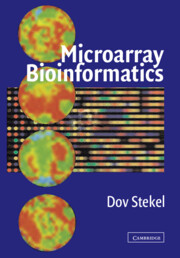Book contents
- Frontmatter
- Contents
- Foreword
- Preface
- Acknowledgments
- MICROARRAY BIOINFORMATICS
- 1 Microarrays: Making Them and Using Them
- 2 Sequence Databases for Microarrays
- 3 Computer Design of Oligonucleotide Probes
- 4 Image Processing
- 5 Normalisation
- 6 Measuring and Quantifying Microarray Variability
- 7 Analysis of Differentially Expressed Genes
- 8 Analysis of Relationships Between Genes, Tissues or Treatments
- 9 Classification of Tissues and Samples
- 10 Experimental Design
- 11 Data Standards, Storage and Sharing
- Appendix: MIAME Glossary
- Index
- Plate section
1 - Microarrays: Making Them and Using Them
Published online by Cambridge University Press: 15 January 2010
- Frontmatter
- Contents
- Foreword
- Preface
- Acknowledgments
- MICROARRAY BIOINFORMATICS
- 1 Microarrays: Making Them and Using Them
- 2 Sequence Databases for Microarrays
- 3 Computer Design of Oligonucleotide Probes
- 4 Image Processing
- 5 Normalisation
- 6 Measuring and Quantifying Microarray Variability
- 7 Analysis of Differentially Expressed Genes
- 8 Analysis of Relationships Between Genes, Tissues or Treatments
- 9 Classification of Tissues and Samples
- 10 Experimental Design
- 11 Data Standards, Storage and Sharing
- Appendix: MIAME Glossary
- Index
- Plate section
Summary
INTRODUCTION
A DNA microarray consists of a solid surface, usually a microscope slide, 1 onto which DNA molecules have been chemically bonded. The purpose of a microarray is to detect the presence and abundance of labelled nucleic acids in a biological sample, which will hybridise to the DNA on the array via Watson-Crick duplex formation, and which can be detected via the label. In the majority of microarray experiments, the labelled nucleic acids are derived from the mRNA of a sample or tissue, and so the microarray measures gene expression. The power of a microarray is that there may be many thousands of different DNA molecules bonded to an array, and so it is possible to measure the expression of many thousands of genes simultaneously.
This book is about the bioinformatics of DNA microarrays: the mathematics, statistics and computing you will need to design microarray experiments; to acquire, analyse and store your data; and to share your results with other scientists. One of the features of microarray technology is the level of bioinformatics required: it is not possible to performa meaningful microarray experiment without bioinformatics involvement at every stage.
However, this chapter is different from the remainder of the book. While the other chapters discuss bioinformatics, the aim of this chapter is to set out the basics of the chemistry and biology of microarray technology. It is hoped that someone new to the technology will be able to read this chapter and gain an understanding of the laboratory process and howit impacts the quality of the data.
- Type
- Chapter
- Information
- Microarray Bioinformatics , pp. 1 - 18Publisher: Cambridge University PressPrint publication year: 2003



